CARING FOR A LIVE CHRISTMAS TREE
Growing up in my family meant reserving the first weekend of December for a drive to a Christmas tree farm for our annual meet up with extended family to cut the perfect tree. It was a tradition we never missed, no matter what the weather- and so having anything other than a live tree never was an option once I had my own household. No matter where I was in life, a live tree has always graced my living area each holiday season.
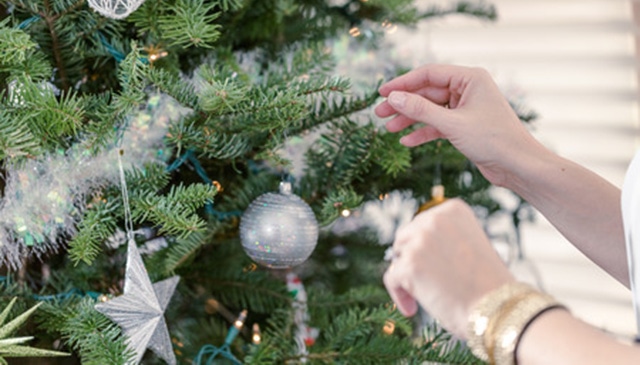
Through the years many people have asked why I bother, and commented on how much extra work a tree takes- except I have never seen a live tree as any extra work at all. Christmas just isn’t Christmas to me without the fresh scent of a newly cut tree, and today I’m going to explain to you just how easy it is to bring a live cut tree into your household for the holidays. Potted live trees have gained in popularity as well, and some simple directions will help you keep yours alive and well until planting time. Read on to discover how to take care of a live Christmas tree this year!
CONTENT
Recently there has been a move towards purchasing live potted Christmas trees (with roots and all) as an alternative to a cut tree. There are definitely some advantages of this option: namely you will get that fresh evergreen smell to permeate through your house through the season. Once you are done with the tree, you can plant it in your yard, or even use one of the many companies popping up across the US that will deliver a potted tree, and then pick it up to plant in a park or other wildlife area once you are finished with it.
Cut trees are easy to purchase as well, and can be found at Cut and Take Christmas Tree Farms where they are grown specifically for the public, bought at your local hardware and garden centers, or even taken from the forest with a special permit you can purchase from your local state or federal government agencies.
POTTED TREE
PROS
- Smells great
- Only needs sporadic watering (as soil dries below the top 2” of soil)
- Is environmentally friendly
- No waste
- Very few dropped needles
- You get to plant it in your yard
CONS
- More expensive
- Will need to allow a cooling off and dormancy period before planting
- Typically much smaller in size
- Difficult to transport
- Fewer choices
PROS
- Smells great
- Shape, size, and species choices
- Can be reused for firewood ro recycled in some areas
- Variety of price choices
- Good availability
CONS
- Needs to be watered almost daily
- Will drop needles
- Needs to be disposed of
- Dry trees can become a fire hazard
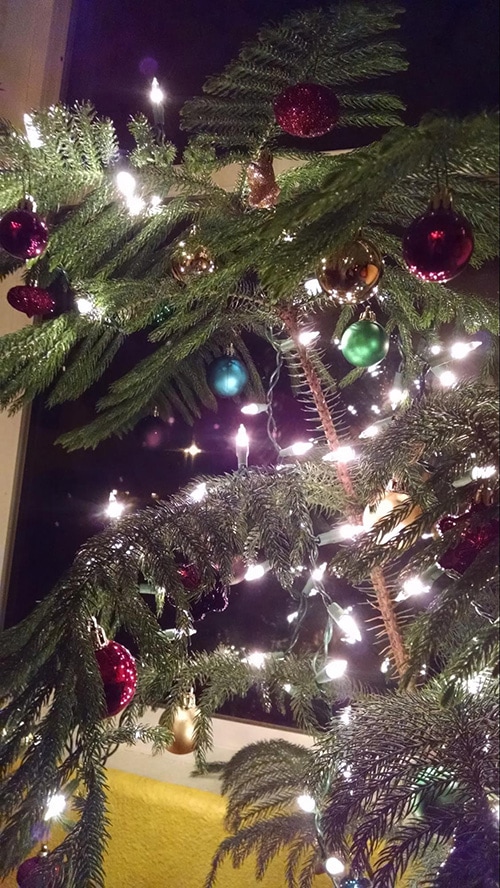
A few years ago I brought home a little Norfolk Pine at Christmas time that I accidentally almost killed off. They are extremely slow growing, so I have kept it potted in the house (or rather what is left of it) since they do not grow well in hot, arid climates. It has done well indoors and each year it’s decorated as our little living tree with mini bulb ornaments. If you want a larger, standard size tree (mine is only about 2 feet high) you will have to do a little research for availability in your area starting in the summer which is when many tree selections are most readily available. Consider the following before purchase:
BUY A TREE THAT IS RIGHT FOR YOUR LIGHT, SOIL, AND ZONAL GROWING CONDITIONS:
A POT THAT FITS YOUR TREE’S WRAPPED ROOT BALL:
A TRANSITIONAL ACCLIMATION ZONE (SUCH AS A GARAGE OR SHED):
A PLACE TO PLANT YOUR TREE:
TREE OF CHOICE
Cut trees come in a variety of heights and branching. The most popular evergreen choices you will have are spruces and firs. Spruce trees have rounded, point needles that are stiff and surround the branches they are attached to. These are very full trees with strong branches that hold heavy ornaments with ease.
Fir trees have flattened needles that are connected to lighter, often more flexible branches. Although main branches will be strong and thick, multiple branching from main stems are softer and more open. These trees are often very popular due to the fact the needles are less sharp, and the branching is less symmetrical and leaves gaps for hanging ornaments to be displayed in.
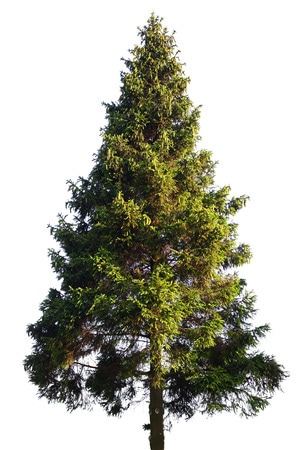
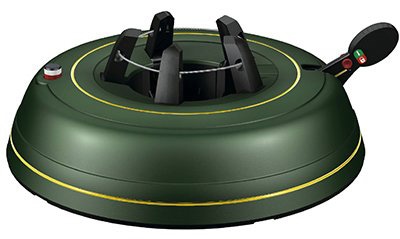
TREE STAND
Tree stand : A cut tree will need to be placed in a stand for both stability and watering purposes. There are a multitude of stand choices on the market, so be sure to choose something that can stabilize both the height and width of your tree trunk with no fear of tipping.

WATER
A cut tree will need to be watered almost daily in order to keep it fresh through the season. This is probably the most important step that you need to make sure you stay on top of. A dry tree not only looks poorly, it can easily become a hazard as well.
OPTIONAL:
Occasionally people will swear by an additive of a tablespoon of corn syrup or sugar to the water, or even an addition of an aspirin, to keep your tree fresh longer. No experiments have proven this as beneficial one way or another, but it cannot hurt the tree.

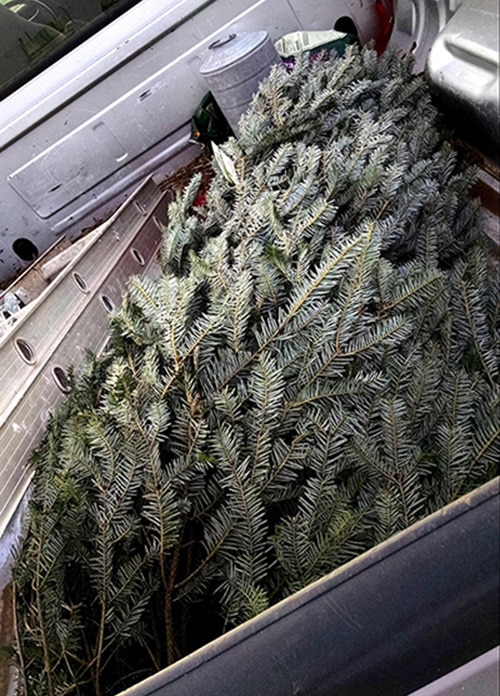
The most important part of bringing home a live cut tree is it’s freshness. Depending on your choices (or available options) of purchase, cutting your own tree guarantees the most fresh tree possible. However, this is not always available in certain areas, and fresh cut trees are often shipped in for purchase to local nurseries.
If you are planning on buying a cut tree from a local store, keep in mind that the most fresh it will ever be is when it is unloaded from the truck it has been shipped in from. In colder climates cut trees will stay fresh longer out of water, but temperatures above freezing and storage in direct sunlight will begin to dry trees out almost immediately, so it is crucial you ask your stores in advance of their tree shipments and purchase one before they have been on the lot for too long without water.
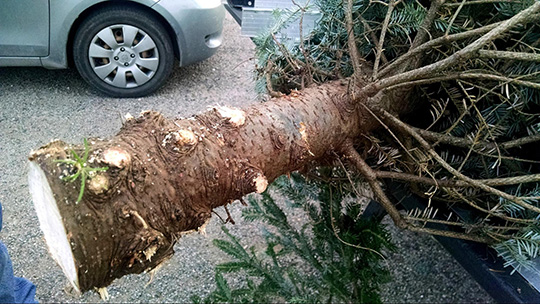
Once you have gotten your tree home, try to get it in water as soon as possible. To ensure good moisture uptake, trim your trunk at least a half inch or more to create a level surface, and clean up the lower branches for approximately 10 to 14 inches. This will keep water from being diverted away from the rest of the tree, as well as provide a nice area under your tree to both water, and place gifts.
STEP 3: SHAKE OUT LOOSE NEEDLES
Even living trees shed their inner needles, and so after you have trimmed your trunk and branches to your desired length and shape, shake out your tree. Feel free to be enthusiastic about this to break loose any needles. It is also helpful to lightly fold the branches down as they were most likely once tied up tight next to the trunk. This helps the branches relax and take on their natural shape, and will also help loosen any dead needles.
Once your tree is the way you want it (feel free to trim up excess branches), place it in your stand and tighten it into place. It helps if you have somebody hold it straight while you get it secure. It is easily adjusted in most stands once the screws are snug against the trunk.
Keeping your tree well watered is crucial to the remainder of it’s life in your house. Not only will a well watered tree not drop as many needles, but it keeps it from getting dried out which can quickly become a fire hazard due to your Christmas lights. Never allow the water to drop below the cut edge of your stump. I keep my water topped off at about an inch below the stand top so I know there is plenty available at all times.
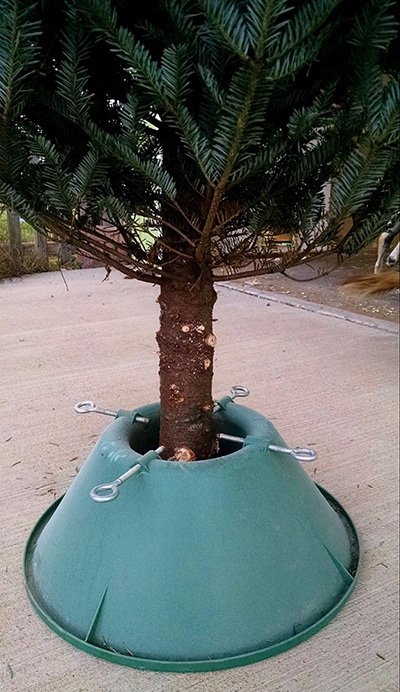

Once your tree is well balanced in the stand, get it situated in the location you want it in your house, and have some fun! Stringing lights, hanging ornaments, and making garlands are all fun traditions I’ve passed down to my children. Enjoy the season with a fresh cut tree and make it a new holiday tradition in your house this year!
If you follow all of the above there is no reason why you cannot enjoy your tree for a month or more this holiday season! I typically put my tree up Thanksgiving weekend and take it down the weekend after New Year’s.
ENJOY!!
Hopefully this has helped explain how to take care of your real tree this season whether you choose a cut, or potted, live tree version. Having a live tree is truly very little effort overall, and is well worth the little bit of extra cleanup you may have once you take it down. All together, it honestly doesn’t take any more time that putting together and taking apart a fake tree!
Do you have any fun live tree stories that you would like to share? Or helpful hints to keep your fresh tree as fresh as possible? We’d love to hear from you below, and if you found this article helpful, please share!

